A Camp Called Justice
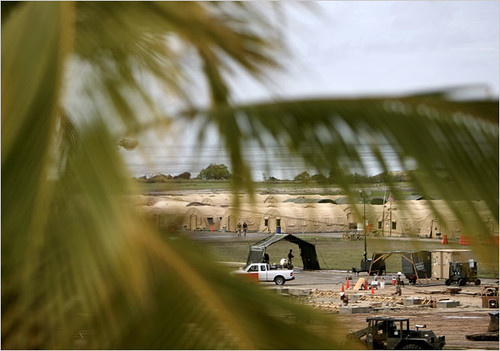
[Image: Portable Halls of Justice Are Rising in Guantánamo, photos by Todd Heisler/The New York Times.]
I'd like to point you to a short piece I wrote for a website called BagNewsNotes, a savvy run-on political scroll founded by Michael Shaw that I will periodically be contributing to, trying to decode the spinster language of visual media and its play with spatial politics. The Bag has a unique way of unraveling the media’s contextualization of images and helps us to read them as strategic props for political theater, and can be extremely valuable to our discerning of how imagery is used to depict the built environment.
Since those pieces are meant to be short and sweet I am going to comment a little further on the topic here in a typically Subtopian clumsy and convoluted kind of way.
Do you remember a few months ago hearing about a proposal floating around to build what would have essentially amounted to a little quaint unknown miniature city on an abandoned airfield at the Guantánamo Bay naval base in Cuba – to house federal judges and other personnel there for the sole purpose of trying detainees under the new laws of the Military Commissions Act? Ring a bell? Well, in any event, at a cost of potentially $125 million it was swiftly shot down by Defense Secretary Robert Gates who even he himself saw the political disaster in that plan, thankfully enough.

However, that “military commission compound” – as it was loosely referred to in our previous coverage – would have in theory accommodated up to 1,200 people and provided the capacity to conduct as many as five trials simultaneously in the first U.S. war crimes tribunals held since World War II. The proposed site we learned was used back in the 1990s to house “a tent camp for Cuban rafters.”
This fact was made even more curious when we later heard that the U.S. Congress approved earlier this year “an $18 million proposal for the Department of Defense to build a migrant detention facility” on the base as well. Or, as The Miami Herald quoted one U.S. official who called it a space “to shelter interdicted migrants.”
This abandoned runway sure is a precarious little strip of land, to say the least.
Though I’m not quite sure what has become of that contract yet there have been (it seems) various attempts to secure Guantánamo’s value in the war on terror by redeveloping and adding significant new permanent structures to it cementing not only the facility itself but the legal architecture that holds the site in place, too. And I find these last couple proposals a bit too eerily synchronized not to be part of a larger strategy to keep the controversial facility from being shut down altogether. Since Congress has faced continuous pressure to close Guantanamo Bay as a detention center – both internally and from governments abroad – it is hardly odd really to find this sudden plan to offshore a brand new warehouse for rounded-up coastal border-crossers (who can under law now be tried as felons or ‘alien unlawful enemy combatants’) and to establish a compound to expedite the rapid legal processing of them once they end up there.
It’s like Gitmo suddenly became a hot new destination for landscape urbanists, or something – really freaky. What’s next, a design competition to green Camp X-Ray? A Best Western hotel tower to watch the little men in orange suits from some prime Caribbean balcony real estate? MTV spring break parties drenching the airstrips in beer, wet t-shirt contests inside hangars, djs mixing the latest Gitmo torture soundtracks?

[Image: Portable Halls of Justice Are Rising in Guantánamo, photos by Todd Heisler/The New York Times.]
In my short for The Bag I call attention to a piece that appeared a couple of weeks ago in The New York Times, profiling none other than the surrogate project that has already begun to take the place of the previously rejected trial complex along side that “unused runway set against the glittering sea” we have come to love so much. This one – called by the Pentagon, the “Expeditionary Legal Complex” – will only cost $12m instead and is expected to be up and running as early as this spring.

[Image: Portable Halls of Justice Are Rising in Guantánamo, photos by Todd Heisler/The New York Times.]
According to the article the court building – “surrounded by trailers, moveable cells, concertina wire and a tent city” – is itself a prefabricated and totally portable kit of parts that’s been shipped to Cuba and, we are told, “could be unplugged, disassembled and put back together somewhere else.” Go figure, justice cast in Lego plastic ready to be made in an infinite reconfigurability of political forms.
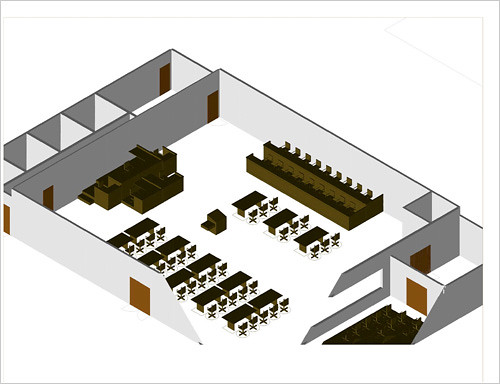
[Image: This is an architectural drawing of the planned interior of a portable, prefabricated, high-tech court being assembled on an unused runway at Guantanamo Bay, Cuba.. For Glaberson Gitmo story. Credit: United States department of Defense, Office of Military Commission. Portable Halls of Justice Are Rising in Guantánamo, photos by Todd Heisler/The New York Times.]
In the Pentagon’s own words it is a state-of-the-art courthouse, completely unprecedented, never before seen, yet described literally by the Times reporter as “a squat, windowless structure of corrugated metal” rigged inside with the latest trial technology – “the perfect architecture for the long-running limbo that is Guantánamo.” Nicely said.
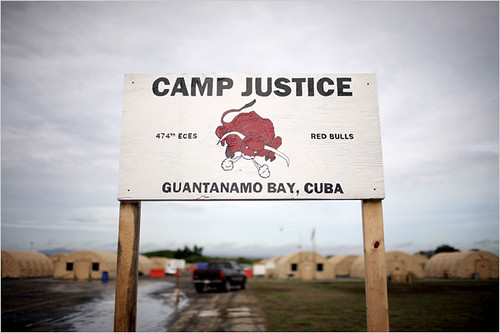
[Image: Portable Halls of Justice Are Rising in Guantánamo, photos by Todd Heisler/The New York Times.]
Like the sign reads ‘Camp Justice’ is – to its credit – just what it says it is: justice in the form of a camp. There is absolutely no pretense here whatsoever, nor can it be mistaken for anything else either, really, which is partially what makes it so disturbing. Not to mention how obnoxious and arrogant it is in its crude declaration of itself. CAMP JUSTICE. We're here. But, again – to be fair – the name does actually say it all.
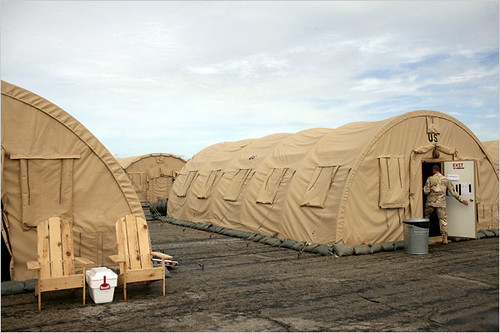
[Image: Portable Halls of Justice Are Rising in Guantánamo, photos by Todd Heisler/The New York Times.]
The definition of camp in this case is a tent city “complete with military cots and a recreation tent” where approximately “550 court officials, lawyers, security guards and journalists from around the world” will live for weeks at a time. Apparently, diesel generators will supply the electricity while everyone including the judges will use port-a-potties. “Showers will be fed by 3,000-gallon water tanks, and food will be shipped in three times a day from kitchens on the base.” The complex in total will be about 6,000 square feet.

[Image: The Rule of Law Complex in Baghdad, photo by Benjamin Lowy for The New York Times.]
Is this a carbon copy of the makeshift Rule of Law Complex looming outside Baghdad we glimpsed in an earlier post? Sure seems like it. Man, these military urbanisms sure are getting good – Architecture for Humanity eat your heart out!
Yeah, right. Good thing I'm kidding. But, let me remind you, according to an older Times story additional complexes have been planned for various regions in Iraq, and I’d be willing to bet that if we took a closer look we might even find similar justice-in-a-can deployments in Afghanistan, Libya, the West Bank, etc. I don’t think it would be difficult to predict the future geographies of portable justice, if you know what I'm sayin'.
If ever there were a spatial qualifier for Giorgio Agamben’s argument that the camp is a space of legal exception or suspended state of lawlessness, then Camp Justice is the be-and-end-all grandiosity of this realization, hunkered down in the mud and all its splendid glory now.
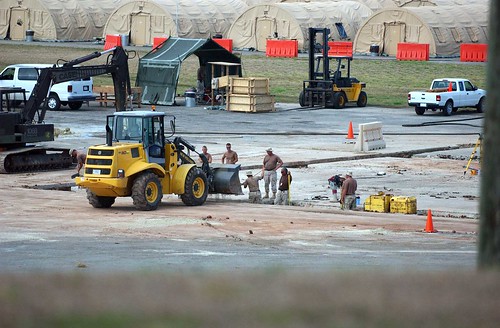
[Image: Portable Halls of Justice Are Rising in Guantánamo, photos by Todd Heisler/The New York Times.]
In a frighteningly lucid and surgical essay Vanishing Points geographer Derek Gregory describes the war on terror as a “war on law”, or a “war through law” – through the suspension of law. While emergency is the state’s tactic it is ultimately the law itself that is the most critical site of political struggle, he contends. If I recall correctly, Derek explains how Guantanamo Bay was established as a purposefully ambiguous political space camouflaged in the folds of legal uncertainty. In short, the U.S. left Cuba while still claiming jurisdiction over the base but not official territorial sovereignty, which allowed it to exist in between a place of law and lawlessness – essentially a place of “indeterminate time” and “indefinite detention.” He calls it a “site of non-place” created for a “site of non-people” located on the peripheral edge – or the “the vanishing point” – of the legal spectrum where international law is no longer enforceable (and therefore non-existent), and where American sovereignty has no application. It is the ultimate space of legal oblivion, you might say.
It is neither a legal nor an illegal space and in all juridical dimensions is neither existent nor non-existent: it is – as far as I can make of it – the production of a convenient and sub-legal nowhere.
Unlike Abu Ghraib that is situated within the legal framework of the law operating under Iraqi sovereignty, and for all intents and purposes is a “legal site of detention”, Guantanamo is an extra-territorial site overseen by no official legal order, but is in fact in a place of the opposite: the very absence of law altogether. Both facilities are translations of a state of exception but arrive there from different proximities and points of intersection with the law.
In the case of Guantanamo Bay, Gregory anatomically dismembers the logistical architecture that’s been used to reshape the legal landscape and the ways existing or future law – or any interpretation thereof – pertaining to Guantanamo has been manufactured, or “performed” he writes, to create a permanent shelter, or shield from proper scrutiny.
Too much to get into here, but if we were to consider the “spatial products” of this performance of law (to borrow from Keller Easterling’s vocabulary), then this pop-up war-machine city with all its transient god-like powers to deliver mortal justice – is an Agamben prophecy made brilliant architectural flesh.
What are we to make of this new Camp Justice as it assumes a role in a space that is already neither considered lawful or unlawful? Are we really supposed to believe that the superficial application of this military pod is going to correct all of the unanswered legal tenets that currently underwrite the (il)legitimacy of such a place like Guantanamo Bay?
Another point he makes about Agamben’s observations is that they are too heavily steeped in a kind of obsession with the look or the image of the camp; with a fetishization of the camp – meaning he falls into the lure of the camp as a kind of political pornography, which I think is an interesting and timely criticism today given how western culture seems so lustful for its own fantasies of the apocalypse. Tracing a visual narrative of those moments in history when mankind was exposed in the raw and suffering image of the camp (the Holocaust, the Native American reservations, the Japanese American internment camps during WWII, and so on), Gregory suggests Agamben’s analysis is distracted by its own morbid aestheticization of the subject and that he fails to observe the more systemic underpinnings of the hidden legal landscape that is responsible for the outcome of the camp in the first place.

[Image: Portable Halls of Justice Are Rising in Guantánamo, photos by Todd Heisler/The New York Times.]
At least that’s how I read it, but this is also sort of what I was getting at with my thoughts for The Bag, how the Pentagon can use this same disaster-fetish to its own advantage; helping the camp to masquerade as some kind of evolutionary moral savior for one the most disconcerting spaces of our times. That is, I think the Pentagon knows how to use the very gratuitous nature of the camp to get the American public to buy into this notion of a higher flexible and dynamic model of delivering global justice in these new and complicated contexts of the war on terror.
And even if no one is buying into the portable justice hype it is ultimately more about the spatial production of a justice concept the U.S. government is able to push regardless – one that’s been designed specifically to operate outside any legal boundary.
So of course, I wonder: could this be that last piece in the spatial puzzle the war on terror needs to complete the harrowing urban totality of a nomadic fortress?
As I tried to articulate in The Bag, it's not a political space they particularly don’t want us to know about or see. Quite the contrary. They are rather proud of their inflatable complexes – their fly-by-night hovering courtrooms – that can be deployed, assembled, disassembled, re-deployed in a matter of hours. And they are more than happy to flaunt its reminiscence of those colonial days when justice strode out across the frontier in wagons and horse-drawn jail cells. And, certainly, they are the least bit ashamed that this kind of squatting legal vestibule exposes the blatant strategy of offshoring detention to these extended voided spaces of legal authority beyond the purview of public supervision that could presumably be cloned anywhere else on the planet at the same time.
In fact, that is precisely what they want us to see – how justice can be ultimately made elastic and modifiable, how it can be architected to fit any set of legalistic circumstances or interpretation thereof; how it can literally remake the political landscape in its own image.

[Image: Portable Halls of Justice Are Rising in Guantánamo, photos by Todd Heisler/The New York Times.]
If this exceptional space keeps expanding through camps like this one and the Rule of Law Complex outside Baghdad, across a landscape already dominated by wandering security walls and traveling “security theater” (that we have observed marking its course countless times already), then let me ask you this: what hope is left in our spatial spheres of observing the law? What is defining what: are our politics defining our spaces or are our spaces defining our politics? I mean if these new transit modules of law enforcement are themselves generated outside any legal domain then have we truly reached the end of justice? Isn’t Camp Justice the ultimate spatial hypocrisy? How do we even begin to consider spatial justice in a context like this?
TEAR-DOWN-THE-WALL.
Additional Linkage:
Justice Considers Revisiting Detainee Hearings (NPR)
Prime BEEF stamps hoof prints on Gitmo (Air Force Link)
Tent city sets up for detainee tribunals (LA Times)
Tent city built for terror trials (Baltimore Sun)
The Rule of Law Complex : Babylon's Crowning Achievement : Gitmo Courthouse Compound goes bye bye : A Mini-city for Trying Terror :
carceral urbanism: the CMU and the Arab round-up : Guantánamo and the Border Exodus : Circus of Detention : The Immigrant, The Camp, and The NYSE : Walkthrough Gitmo: the de-restricted fortress : Instant Democracy: The Pneumatic Parliament : Architects of Nebulous Detention







2 Comments:
good stuff! but did you mean "sinister" rather than "spinster language of visual media and its play with spatial politics"?
ha. i actually meant spinster, as in political spinsters, but - sinister, spinster, it's all the same... give or take a letter or two.
thx anne!
Post a Comment
<< Home